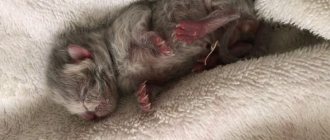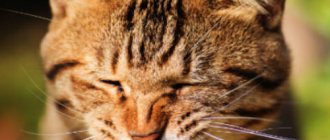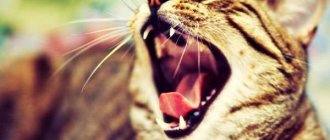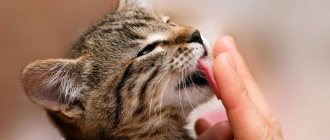A miscarriage in a cat is an unpleasant event for both the pet and its owner. Unfortunately, not a single cat is protected from spontaneous abortion: its causes may lie in the genetics of the animal. Contrary to popular belief, recognizing a miscarriage is not so easy, since the cat often eats both the embryos and the placenta. In other cases, the fetuses may remain in the mother’s womb altogether, further threatening her health. What types of miscarriages exist, what kind of help can be provided to a cat that has gone through a spontaneous abortion, we will tell below.
Miscarriage in a cat: causes and help
Causes of miscarriages
There are two general groups of reasons that can cause spontaneous abortion in a cat:
- primary, caused by genetic characteristics and various infections;
- secondary, caused by environmental factors and the location of the placenta.
Primary
The primary causes, as you might guess, are very difficult to combat, since traits inherent in genetics are hardly amenable to correction. Meanwhile, there are breeds whose females are predisposed to miscarriages in the absence of visible health problems: such breeds include Persian and Himalayan cats .
Primary miscarriage is very difficult to predict and almost impossible to predict.
When it comes to infections, the pet owner already has more control over the situation. You can avoid miscarriage in the event of an infectious infection by taking care of timely vaccination of the cat before mating and pregnancy, as well as good living conditions for the animal.
Secondary
The secondary causes of miscarriages in cats include three main factors:
- placenta previa. Placenta previa refers to its incorrect location in which the placenta partially or completely covers the uterine os. It should be noted that this phenomenon is rare and is more often observed in cats that have already given birth once;
- injuries. Regarding injuries, everything is very clear: any bodily injury inflicted on a cat during pregnancy can threaten both its life and the life of the fetus;
- impaired blood circulation between the uterus, placenta and embryos. Poor circulation can have many causes - from poor nutrition to severe and prolonged stress.
Secondary miscarriages often occur due to injury
In addition to primary and secondary, some veterinarians also identify an additional group of causes, which includes the following factors:
- metabolic disorders in the animal's body;
- intense experiences;
- inbreeding (crossing of closely related individuals);
- inappropriate age of the animal (it is advisable to allow females to mate that have already reached full physiological maturity and do not show signs of aging. The age of such cats ranges from one to six years).
Before mating animals, it is necessary to carefully select a partner suitable for the female
Preventing miscarriage
Miscarriage in a cat is rare. For the most part, pregnancy proceeds without any particular complications, and the cat also copes with childbirth on its own. But this situation can and should be avoided:
- If a cat’s pregnancy is planned (this applies to breeding sires), then before conception the cat should be examined by a veterinarian for possible diseases and preventive measures.
- If the pet is of “noble” origin, this does not negate the fact that it has all the required vaccinations and anti-parasitic treatment procedures. If a person has taken responsibility for an animal, then it should be fulfilled in full.
- You should not suddenly change your diet once you become pregnant. The cat should eat its usual food.
- It is necessary to take a course of vitamins during pregnancy, which will be recommended by the veterinarian.
Observation by a veterinarian
As mentioned above, consultation with a specialist is necessary before planned conception. But even during pregnancy you should not neglect visiting a doctor:
- the veterinarian will give the necessary recommendations, prescribe a course of vitamins, and examine the cat by taking samples;
- after the 4th week, you can do an ultrasound to make sure that the kittens are alive and positioned correctly, the uterus is in good condition;
- Closer to childbirth, it is better to invite a doctor for an examination at home, so as not to irritate your pet with the trip, he will make sure that she is feeling normal and there are no signs of premature birth.
Nutrition
A cat's diet during pregnancy should be balanced. She should receive enough vitamins. This is not difficult to do if the cat eats dry food. Many manufacturers have lines of food specifically for expectant mothers.
High-quality dry food intended for pregnant and lactating cats will provide their body with all the necessary elements
If the cat eats natural products, then taurine should be included in the diet. This element prevents premature termination of pregnancy and reduces the risk of abnormalities in the fetus. It is impossible to overdose; excess is simply eliminated by the body. It is contained in:
- red meats and fish;
- chicken heart and liver;
- turkey meat (champion in taurine content).
The need for rest
During pregnancy, the cat needs to be given the maximum opportunity to rest peacefully. The animal's activity decreases. It is very important to explain to children that rough play with a pet is unacceptable. You should not pick up the cat unless necessary, so as not to put pressure on the stomach.
The effect of infections on miscarriage
Both viral and bacterial infections can cause miscarriage. The most dangerous infections that threaten the successful course of pregnancy in a cat are given in the table below.
Table 1. Infections that threaten cat pregnancy
| Name | Symptoms |
| Calcivirosis | 1. The animal's mouth, nose and tongue become covered with ulcers, resulting in profuse salivation, leading to sticking of the fur around the mouth. 2. The cat sneezes often. 3. There is frequent discharge from the eyes and/or nose. 4. The general condition of the animal can be described as depressed: the cat moves little, has no interest in food |
| Rhinotracheitis (herpes) | Most of the symptoms of rhinotracheitis are similar to the symptoms of calcivirosis, so it is very difficult to make a correct diagnosis at home. Cats infected with this disease begin to sneeze, they develop discharge from the nose and eyes, their body temperature rises, and they refuse to eat. The only difference: with rhinotracheitis, the ulcer spreads mainly to the eyes |
| Panleukopenia (distemper) | 1. The incubation period is characterized by a general deterioration in health, lethargy and refusal to eat, as well as bouts of vomiting interspersed with blood and mucus. 2. The cat’s temperature begins to rise, which can rise to 42 °C. 3. Diarrhea is added to vomiting; its consistency is similar to water and leads to even greater dehydration of the body. 4. As the disease develops, cats' gums turn blue and their larynx swells. It should be borne in mind that the death of an animal can occur suddenly, even in the absence of an incubation period, if we are talking about a hyperacute course of the disease |
| Leukemia | 1. The cat's lymph nodes are enlarged. 2. The cat is losing weight due to loss of appetite. 3. The animal's fur becomes significantly worse in quality than before. 4. The cat develops inflammation localized in the oral cavity (stomatitis). 5. Body temperature rises. 6. Attacks of diarrhea are possible. Please note that different cats with leukemia exhibit different groups of symptoms. |
| Escherichia coli | 1. Lack of appetite in the animal is accompanied by noticeable emaciation. 2. The cat shows aggressive resistance when the owner or veterinarian tries to feel its stomach. 3. The cat is constantly or occasionally feverish. 4. The animal often vomits for no apparent reason. 5. The cat has bouts of diarrhea. 6. Against the background of E. coli, the pet may also develop rhinitis or some signs of conjunctivitis. 7. Dehydration due to vomiting and diarrhea |
| Hemobartonellosis | The main feature of this disease is that it is difficult to recognize. It may not manifest itself in the animal’s body for more than one year, poisoning its life and not giving any warning signs to the owner. Among the nonspecific symptoms that may indirectly indicate hemobartonellosis are the following: 1. The cat has a constantly elevated temperature. 2. There is a rapid heartbeat and rapid breathing. 3. The pet begins to experience an unhealthy interest in inedible objects - sand, plastic, food waste. 4. The mucous membranes turn pale or turn yellowish. 5. The animal gets tired faster than usual and spends a lot of time lying down. Miscarriage in a female with hemobartonellosis occurs due to maternal anemia, which contributes to the death of embryos |
How to prevent your cat from getting infected?
Despite the fact that the infections listed above have varying degrees of impact on the body, they are almost equally dangerous for a pregnant cat. You can protect your animal from this group of diseases using the following methods:
- careful adherence to hygiene standards when keeping a cat;
- a ban on independent walking (this way you can prevent the female from meeting potentially infectious stray animals);
- timely vaccination;
- creating a healthy diet;
- preventive examinations at the veterinarian and passing all prescribed tests (especially during pregnancy).
Vaccination given before mating will help prevent infection of a pregnant female.
If you monitor your pet's health and look for alarming changes in behavior, you will be able to maintain normal health and promote the survival of the fetuses. Many infectious diseases, if we are talking about an already infected female, can be successfully cured in the early stages without consequences for the animal.
Preventive actions
Spontaneous abortion often occurs without symptoms ,
and whether a cat can have a miscarriage cannot be determined without special research. However, knowing about the existence of such a threat, the owner can take preventive measures:
- carefully select parental pairs to exclude inbreeding;
- stop mating animals older than 6 - 7 years;
- diagnose infectious diseases in parents before mating;
- prevent poisoning;
- encourage physical activity during pregnancy;
- carry out preventive measures against injuries, falls from height, bruises;
- choose a diet balanced in protein, taurine, vitamins and minerals.
Following the recommendations will reduce the risk of spontaneous abortion in your pet.
A miscarriage in a cat is an unpleasant occurrence for the owner and unsafe for the health of the animal. Spontaneous abortion often occurs asymptomatically, which makes diagnosing the pathology difficult. Preventive measures can reduce the likelihood of pathological abortion and complications after pathology.
We recommend reading about what owners should do if their cat has a miscarriage. You will learn about the types and causes of pathology, consequences for the cat’s health, and medical measures for miscarriage.
However, it often happens that a cat becomes infected after mating. If a pregnant cat has worms, what should you do in this situation? . For a pregnant cat, this can result in miscarriage or fetal pathology.
You will learn about the types of cysts and cystomas, the causes and symptoms of polycystic ovaries, their diagnosis and treatment. And here is more information about what owners should do if their cat has a miscarriage.
What to do if a cat has a stomach ulcer. . Miscarriage in a cat: what to do, why it happened. How to understand that a cat is giving birth? How many times a year does a cat give birth?
Miscarriage in a cat: what to do, why it happened. Polycystic ovary syndrome in cats: causes, symptoms. Marina (content manager).
A miscarriage in a cat is a spontaneous pathological termination of pregnancy (spontaneous abortion).
Non-infectious causes of miscarriage
The main non-infectious preconditions for miscarriage include:
- uterine torsion;
- various pathologies of embryonic development;
- endometriosis (in the case of cats they often talk about pyometra );
- neoplasms of the genital organs;
- hormonal imbalances in the female body.
We will talk about each of these factors below.
Uterine torsion
Torsion refers to the rotation of the fertilized uterus or one of the sections of its horn by 180 degrees (sometimes more) around the longitudinal axis. This pathology is rare and appears closer to the time of birth. It can be caused by even one careless movement or an unfortunate fall of the pet.
Uterine torsion poses a serious threat to embryos
In most cases, uterine torsion can be corrected through surgery if promptly consulted by a veterinarian. If the cat is not helped, then there is a great danger of the death of the fetuses in the womb of the animal and their subsequent rotting, causing necrosis of the uterus and posing a danger to the animal.
Pathologies of embryonic development
Pathologies of fruit development include their excessive enlargement or, conversely, too slow a rate of development. Also, the fetuses may be positioned incorrectly in the uterus, which will cause their rejection. Various chromosomal abnormalities can also interfere with the correct development of embryos, leading to the non-viability of the fetus.
Pathologies of fetal development can be observed even in completely healthy cats.
Endometriosis
For cats, the most common type is pyometra, a purulent type of endometriosis. Pyometra is dangerous because in its chronic form it can last for months, while it is very difficult to recognize it, since a sick cat sometimes continues to have regular estrus. Pyometra itself occurs as a result of the entry of conditionally pathogenic microflora into the organ cavity and the subsequent accumulation of decay products in the uterus.
Pyometra often occurs in a latent form, worsening during pregnancy
Pyometra is life-threatening for a cat, regardless of whether she is pregnant or not, and requires prompt medical intervention. The only group of cats that are not at all afraid of this disease are females that have undergone sterilization.
Neoplasms of the genital organs
Neoplasms can be either benign or malignant. Most often they are found on the ovaries. There are three most common types of tumors:
- folliculoma represents about half of all neoplasms encountered. It often has a malignant nature and the ability to metastasize to nearby organ systems, growing through the ovarian membrane;
- dysgerminoma is an ovarian tumor that is more common in young females. It very rarely gives metastases and does not extend beyond the designated organ. Affects the functioning of the body only with a significant increase in size, can contribute to torsion of the uterus, as well as deterioration of the intestines and bladder;
- Teratoma is the least common tumor among those presented. In most cases, the tumor manifests itself as malignant and prone to metastasis. To identify such a rare neoplasm, the animal is prescribed an abdominal CT scan.
Some diseases of the reproductive system can only be detected using MRI or CT
If we talk about uterine tumors, such variants are very rare in cats. The most common tumors localized in this organ are endometrial adenocarcinoma and fibroma.
Hormonal disbalance
Hormonal imbalance is not a disease as such; it includes a list of ailments such as diabetes (sugar and insipidus), Addison's disease, Cushing's disease , hypo- and hyperthyroidism. All of these diseases are in one way or another associated with dysfunction of organs that produce various hormones - the pituitary gland, thyroid gland, adrenal glands and ovaries (if we are talking about females).
Cats with diabetes are more likely to miscarry
Symptoms of hormonal imbalance, depending on the disease, may be exactly the opposite. For example, with diabetes, cats experience an unnaturally increased appetite, while with hypothyroidism the animal loses interest in food. To make sure that there are no hormonal disorders in the cat’s body before mating, you should undergo appropriate tests.
Types of miscarriages
Veterinarians distinguish three main types of miscarriages, depending on both the timing and the reaction of the animal’s body. Let us immediately note that a miscarriage (despite its name) does not always involve the direct removal of the fetus from the cat’s body.
Table 2. Types of miscarriages
| View | Description |
| Miscarriage in the early stages of pregnancy, accompanied by resorption of the fetus in the uterus | This type of miscarriage is the most harmless for the animal and completely invisible to humans. When the embryos are reabsorbed, the cat does not experience pain, and no discharge comes out of its vagina that could alert a person. In some cases, only a few fetuses are resorbed, while other embryos continue to develop. The reasons for such a miscarriage may be inbreeding or genetic abnormalities |
| Intrauterine death of fetuses with their subsequent removal from the uterus | This disease can befall a female at any stage of pregnancy. This type of miscarriage is considered “classic”. Removal of the fetus is accompanied by heavy bleeding with added mucus from the cat’s vagina. Even such obvious signs may remain unnoticed by the owners, since females tend to hide what happened and eat both embryos and afterbirth. This behavior is explained by instincts and self-preservation |
| Intrauterine death of fetuses without removal from the uterus | This type of miscarriage is the most dangerous because it directly threatens the life of the female. Mummifying or rotting fruits in the uterus release toxins that lead to inflammation of the organ. Symptoms of inflammation are the same blood discharge as in the previous case. However, this time the vaginal discharge is accompanied by a strong putrid odor, indicating that the fetuses remain inside the uterus. If you don't help your cat in time, she risks dying or becoming infertile. |
Signs of abortion in cats, when you can recognize that a cat has miscarried
Symptoms of abortion and pregnancy loss in cats (but these symptoms do not all occur at once):
- Abortion can be asymptomatic, especially in the early stages of pregnancy without infection.
- Absence of signs of pregnancy (when they should appear, i.e. enlarged abdomen, increased appetite, etc.).
- Reducing the volume of the abdomen if the pregnancy was already at an advanced stage.
- Detection of fetuses and placentas if the cat has not eaten them.
- Anorexia (refusal to eat)
- Vomiting and diarrhea (especially if the cat has eaten the fetuses and placenta, but can also be due to internal poisoning).
- Weight loss
- Purulent or bloody discharge from the genitals, which may not be noticed in cats that constantly lick themselves.
- Abdominal discomfort and tension.
- Depression
- Dehydration (dehydration).
- Fever
How to recognize a miscarriage?
Throughout pregnancy, it is important to closely monitor the cat in order to promptly identify dangerous symptoms (if any). From the table above, it is easy to conclude that a miscarriage is not always as obvious as it seems at first glance. Often it has to be recognized by indirect signs, such as:
- absence of obvious signs of pregnancy in the cat several weeks after mating;
- with a late miscarriage, the pet’s belly often becomes asymmetrical and changes its previous shape;
- diarrhea or vomiting;
- general depression, combined with loss of body weight;
- aggressive reaction to the owner’s attempts to feel the stomach;
- temperature rise above 39°C.
Often a cat tries to hide or eat the consequences of a miscarriage so as not to leave “evidence”
Among the more obvious manifestations that clearly indicate a miscarriage, we note the following symptoms:
- vaginal discharge mixed with blood (it should be noted that in late pregnancy, the discharge of clear mucus from the vagina is not an alarming symptom);
- a sharp unpleasant odor emanating from the pet;
- the presence of fruits and afterbirth (sometimes cats do not touch them and leave them in the most visible place).
Consequences of miscarriages
Spontaneous abortion in most cases is stressful for the cat's body. The only exception is that fruits that dissolve in the early stages do not cause any discomfort. The following miscarriage scenarios are most dangerous for a cat’s health:
- miscarriage in late pregnancy. It is logical to assume that the more developed the fetuses are, the more painful it will be for the animal to experience their exit from the uterus. Such a miscarriage sometimes ends with rupture of the reproductive organ or birth canal. Even if this does not happen, the animal is severely emaciated due to the loss of a large amount of blood;
Miscarriage in late pregnancy is the most difficult for cats
- miscarriage not accompanied by expulsion of the fetus from the uterus. Decaying embryos poison the cat’s body and in the future can even lead to necrosis of the uterus if they are not removed from it in a timely manner. Another serious consequence of this type of miscarriage is infection of the pet’s blood.
The consequences of a miscarriage are not always visible to the naked eye.
Regardless of the type of miscarriage, veterinarians note the following impact of this unpleasant episode on the cat’s future life:
- the animal has permanent foci of inflammation of the reproductive organs;
- experienced spontaneous abortion most likely leads to infertility of the cat;
- a miscarriage will likely have a negative impact on all subsequent pregnancies, worsening their course and complicating labor.
Sometimes, after a miscarriage, a cat loses the opportunity to become pregnant again.
Complications of pregnancy in cats (relatively harmless)
• Intestinal disorders (diarrhea)
As a rule, such complications arise during early or late pregnancy of cats, with improper nutrition of cats, as well as when pregnant cats are on the street, hypothermia and overheating.
All these complications require treatment and monitoring by a veterinarian. They usually go away immediately after pregnancy and do not have a significant impact on the cat's health, but can lead to complications during birth or to health problems in kittens. Each such complication has its own symptoms and its own methods of treatment.
With proper care, nutrition and general health of the cat, complications during pregnancy do not occur. In general, feline miscarriages and other complications are uncommon.
What to do if your cat has a miscarriage?
What should an owner do if he observes symptoms of spontaneous abortion in his pet? Firstly, he should contact a veterinary clinic and call a specialist to his home, since transporting an animal in this condition is extremely undesirable. Secondly, the owner must go through with the cat all the tests that the veterinarian prescribes.
Standard tests given to cats following a miscarriage include:
- tests for hormone levels in the blood;
- X-ray;
- ultrasound examination of the abdominal area (if necessary and CT);
- smear from the uterine cavity;
- various tests for infectious diseases.
If a miscarriage does occur, it is important to save the embryos and transfer them to the doctor for testing.
If the owner of the animal discovers fruits rejected by the cat’s body, under no circumstances should he get rid of them. Embryos are valuable material, the study of which will allow us to more accurately determine the causes of spontaneous abortion. This material should be placed in a plastic bag, carefully sealed, and given to the doctor.
Treatment and further care of the cat if a miscarriage has already occurred
After a miscarriage, the cat must be shown to a specialist. Usually owners panic and simply call a doctor to their home. This is a very correct decision, because the cat needs help as early as possible. But after the incident, in any case, you should visit a veterinary clinic. The specialist will perform an ultrasound to ensure that all kittens have been born and will prescribe hormone therapy to completely cleanse the uterus.
An ultrasound after a miscarriage helps make sure that there are no embryos left in the uterus
Necessary medications
If it is not possible to quickly call a doctor, then glucose solution and Travmatin will help the owners. They will greatly ease your pet’s condition and help him recover. They must be used according to the instructions, but it is better to consult with a veterinarian, at least by phone.
Travmatin is a complex homeopathic preparation that, thanks to a unique combination of components, has the ability to have a beneficial effect on the source of inflammation, significantly accelerating the restoration of damaged tissues in the animal’s body.
Telephone consultation is a service that is now quite common. Having several cats and a dog, I also have a permanent doctor who takes care of them and gives them vaccinations. His phone is magnetically stuck to the refrigerator door so that in case of an emergency, I or the rest of the household can contact him. So, when we took in foundlings for our nursing cat, one of which was very weak, it was over the phone that the doctor suggested how to supplement the baby’s feeding and properly care for him.
How to protect a cat from miscarriage?
Despite the fact that the owner cannot influence the pregnancy of his cat in one hundred percent of cases, he is still able to protect the animal as much as possible from the harmful consequences of gestation.
In order for a cat to cope successfully with pregnancy and childbirth, the owner needs to take into account a number of factors:
- To avoid inbreeding, carefully select a partner for your pet;
- do not allow animals that are too old or too young to mate;
- have your cat examined by a veterinarian immediately before crossing;
- vaccinate both partners some time before mating.
In order for a cat to successfully endure pregnancy and childbirth, it is important to take care of its maintenance both before and after mating.
Among other things, it is also necessary to monitor the proper nutrition of the female and prevent the presence of low-quality or spoiled foods in her diet. It is recommended to stimulate your cat to moderate physical activity so that she does not gain too much weight.
It is important to be able to distinguish a miscarriage from the onset of labor. Information on how to understand that a cat has begun to give birth and what supplies the owner will need to correctly give birth can be read below.
Preparing for the birth of a cat
You can also read more about how to give birth to a cat
Reviews
I was in heat on February 14th, we took her to a cat, she was pregnant, everything was fine, she was fed, loved, cherished, and now I find him dead. Her belly is still the same as it was. She had 3 kittens, she gave birth to all of them prematurely, it’s good that the cat was saved. 3 days of IVs, a lot of injections... now you can at least look at her, otherwise you won’t be able to look at her without tears... This is our first experience.
Catherine
https://www.babyblog.ru/community/post/petsandcats/3060263
Today my cat gave birth to five dead kittens at term. The kittens are clearly frozen because... small, and had not moved for a long time, probably three weeks since I first thought that something was wrong. The belly has stopped growing. It seems to me that they froze at different times, because... they were all different sizes. I injected her with oxytocin - three injections of 0.2 and the last 0.4. We will inject 1.5 ml of Gamavit for five days. Some kind of antibiotic twice - today and in two days. (given by our club chairman, who was injecting her cat in a similar situation.
Senior cat specialist
https://www.catgallery.ru/forums/index.php?showtopic=11195
The Scottish cat was pregnant for 1.4 months (1 mating), on days 45–50 they began to notice that the cat was licking itself more often than usual. On day 50 we noticed red mucus and took him to the clinic. They gave the cat an ultrasound and said everything was ok. They suspected vaginitis and prescribed rinsing with chlorhexidine. After 3 days, the cat began to actively lick itself, then gave birth to two non-living kittens (very small). Three days have passed and she still has red mucous discharge (not a lot).
Levitee










